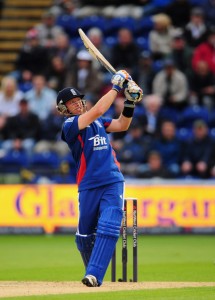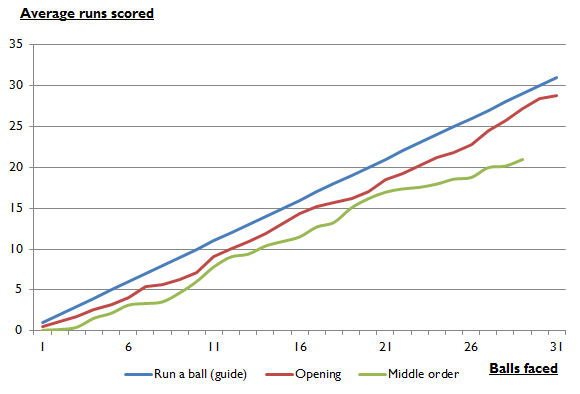
A gradual but inevitable descent into cricket-based loathing and bile.
The Kieswetter Experiment
After three long years it appears that England have finally given up on their attempts to incorporate Craig Kieswetter into their ODI side. It’s taken 46 painful matches, during which our swear jar very nearly made it into the Sunday Times Rich List, but it seems that the penny has finally dropped. But is Kieswetter entirely to blame? Or has he been mishandled by the various bits of the England management? And we don’t mean that in a Jimmy Savile way – get your minds out of the gutter.
The important thing to remember is that Kieswetter is a very specific type of player, with a very clear role in the side. When he was first introduced to the England ODI side his role was defined: an opening batsman who looked to hit the ball over the top in the opening overs. Back in 2010 the powerplay regulations meant that the first ten overs were compulsory, with the next five overs also being powerplays in the vast majority of cases. That gave 15 overs in which a pinch-hitter could spend a few balls judging the conditions before going on to flourish, especially on flat pitches such as those in Bangladesh, where Kieswetter was first introduced (giving new hope to a whole generation of square faced kids).
Indeed, Kieswetter’s role was so specific that it didn’t even include keeping wicket for that first series; Matt Prior kept the gloves to begin with. Hence Kieswetter’s 107 in the third match can’t even be added to the pitiful list of England ODI wicketkeeper centuries, a list that has Alec Stewart’s name on it four times. And no-one else’s. That’s right: in just short of 600 ODIs England’s wicketkeeper century tally stands at four, a genuinely incredible statistic. By way of comparison, Australian wicketkeepers have managed 19 hundreds, Indians 11 and South Africans nine. Even Afghanistan have managed it three times.
Of course, that hundred raised a fairly obvious question for the England hierarchy: why do we need a misfiring wicketkeeper at number seven when we have one smashing hundreds at the top of the order? Hence for England’s next ODI (against Scotland, a match we’ll talk more about later) Kieswetter took over behind the stumps, with everything set for him to become the new Adam Gilchrist, smiting attacks across the globe.
Obviously that didn’t happen and Kieswetter stuttered through a series of block/block/slog the ball straight up in the air innings. By the end of 2011 he’d played 28 matches and made 809 runs at an average of 29.96 and strike rate of 94. Certainly not dismal statistics, but nothing to write home about either. Compared with some of the previous incumbents they were actually decent numbers. But it’s here that England made a clear handling error. Having been beaten 5-0 in India, they looked to make an adjustment to the team to try and get more out of Kevin Pietersen, moving their big name batsman up to open for the 2012 series against Pakistan in the UAE, a series that England won 4-0. As a result Kieswetter was shifted to the middle order, despite being the only England batsman to score at better than a run a ball in the aforementioned India series. This was then followed by another adjustment, with Ian Bell coming in to face the two new balls, albeit an adjustment that didn’t affect Kieswetter.
Square faced Craig was now a square faced peg in a round hole. A player who thrives on having the new ball, restrictions on the number of boundary fielders and having the whole innings in front of him was now being asked to come in during the final overs and immediately hit the old ball around against defensive fields. The sensible thing to do would have been to consider the role and find the best player to fill it. Instead the England management simply tried to change the type of player Kieswetter is.
In purely statistical terms, Kieswetter’s spell down the order is actually relatively similar to his effort at the top of the order:
| Batting position | Matches | Batting average | Strike rate |
|---|---|---|---|
| Opening | 28 | 29.96 | 94.18 |
| Middle order | 18 | 30.63 | 78.27 |
While the batting average is very similar there’s a clear drop in strike rate (of roughly 17%) when Kieswetter was down the order. In itself this isn’t that surprising; Kieswetter simply isn’t that well suited to working the old ball around at the end of an innings. He doesn’t have the variety of shots that the likes of Eoin Morgan and Jos Buttler (his current replacement) have, that knack of finding a way to get the ball into the gap, wherever that gap may be.
In many ways, we already have enough evidence to prove our point about square pegs and round holes. However, we couldn’t turn down the opportunity to stick the boot in a little more so we went a step further and looked at the shape of the average Kieswetter innings. In order to do this we’ve looked at his average score after each delivery of his innings (so his average score after one ball, then his average score after two balls and so on).
A couple of quick caveats around this analysis: we’ve chosen to exclude a couple of innings. The first of these is Kieswetter’s 69 against Scotland, which we’ve excluded because (a) Scotland are rubbish and (b) because the ball by ball commentary for that particular match is all over the shop, like Oliver Reed on Wogan that time. There are overs with three boundaries that go for 11 runs, Strauss having all the strike even when an over finishes without the batsman changing end and Kieswetter being 73* shortly before getting out for 69. Honestly, if you can figure it out you deserve a medal.
The second innings we’ve excluded was square faced Craig’s 0* (0) against Australia at The Oval. Even we’re not cruel enough to use the fact that he didn’t even face a ball against him.
Excluding those two exceptions, we can calculate the average number of balls per innings. That’s the average number of balls faced, regardless of whether the innings ended due to Kieswetter slapping the ball straight to long on, the 50 overs being up or the match being abandoned due to the wrong type of rain falling. For innings as an opener that average works out at 30.68 balls per visit to the crease (which we’ll round up to 31), whereas in the middle order it’s 28.36 (which we’ll cheekily round up to 29).
Now all we do is plot the average score after each ball and plot them on a graph. A graph that looks rather like this:
Here we have three lines. The blue one is simply a straight lines with runs and balls faced, i.e. a guide for a strike rate of 100. The red line shows an average innings for Kieswetter opening the batting, while the green line does the same for him coming in in the middle order.
There’s clearly a huge distinction between the two. The red line trundles along at a reasonably constant rate, never dropping too far below the blue line. However it’s the green line that is genuinely interesting. For a start it is always below the red line. Also, it has a couple of areas in which it flatlines (the first three balls and balls six to eight) and by the end it’s getting further and further away from the blue line. This is what a block/block/slog innings looks like. You can see the way Kieswetter would get to (on average) 3.55 runs from his first eight balls and then throw the bat, aware of the mounting pressure. Ditto around the 18 ball mark. And then you can see the innings tailing off horribly towards the end before reaching its natural conclusion, usually in the safe hands of long off.
Or it could just be us seeing things that aren’t there due to excessive gin consumption. Either way, the point remains: Kieswetter is (and was) completely the wrong player for the number six role in England’s ODI side. All he’s done wrong is prove that fact over the course of three years. And cost us a f**ing fortune in the process.




No Comments
Post a Comment